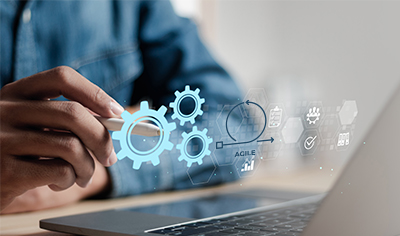Today digital transformation has become the norm across all industries. Even though most organizations have already modernized their IT infrastructure, many businesses continue to stick with legacy systems for business-critical operations. They might think they’re pinching a few pennies by waiting to modernize, but the reality remains that maintaining legacy systems will cost more in the long run. Gartner estimates that by 2025, organizations will be spending 40 percent of their IT budgets on maintaining technical debt, and if you still have legacy systems in place, you can expect a yearly 15% budget increase. Plus, in a number of cases, software maintenance costs alone have made up to 90 percent of the cost related to the software life. These figures alone underscore the importance of software product modernization. In this blog, we will explore why modernization is a necessity, not a choice.

Use Cases of Legacy Software Product Modernization Across Industries
| Industry | Use Cases |
|---|---|
| Finance |
|
| Healthcare |
|
| Manufacturing |
|
| Retail |
|
| Telecommunications |
|
7 Reasons to Consider Legacy Software Product Modernization
Here are the key reasons to opt for legacy software product modernization:
1. Improved Efficiency
In the highly competitive environment prevalent these days, businesses can no longer afford delayed processing of tasks. Given that companies are now adopting a customer-centric approach, every second wasted contributes to a diluted customer experience.
However, outdated techniques, such as manual data entry, will only cause lags. This delay will accrue in the succeeding stages.
On the other hand, product modernization solutions enable you to streamline the workflow while maintaining greater accuracy. Hence, your customers and employees will benefit from a swift and seamless experience.
2. Efficient Human Resource Management
As per G2’s State of Software Happiness Report, 51.95% of employees are unhappy with the software solutions that their organizations use. Furthermore, about 75.94% of employees have considered leaving their jobs due to the lack of the right software. Clearly, now is the time to transform your legacy systems and make them more employee-friendly. This can be done by investing in product modernization services and solutions.
Replacing legacy systems with automated solutions helps you make efficient use of human resources by eliminating the need for carrying out redundant or recurring tasks. In this manner, you can reserve talent for more challenging work.
3. Increased Profitability
Outdated technologies often rely on paper-based methods to collect data. The additional steps required to digitize and utilize data make the process even more complex and resource-intensive. Maintaining such records and systems and employing a larger workforce increases your financial liability. Plus, with the passage of time, maintaining outdated systems will get proportionately expensive. It is also worth mentioning that dated systems lead to unnecessary delays, which could potentially cause revenue losses in certain industries. As such, these are a drain on your finances in more ways than one. Legacy system modernization can contribute to significant cost-savings in the long run and can revenue growth, ultimately boosting profitability.
4. Enhanced Data Quality
When discussing losses caused by legacy systems, the losses due to poor data quality bear special mention. Manual processes compromise data fidelity, which could affect your bottom line. According to a Gartner report, bad data and errors could result in nearly $15 million per year!
Additionally, human mistakes can introduce errors that avalanche and expand exponentially only to hamper the operations and the resultant output. Intelligent Process Automation, a crucial aspect of product modernization solutions, efficiently weeds structured and unstructured data to mitigate this effect and decrease the likelihood of error occurrences while also bridging organizational goals with reality.
5. Bolstered Security
If you are handling sensitive or confidential data, then operating through legacy systems could lead to your downfall. Most cybersecurity solutions rely on lean IT infrastructure wherein there is a need for continuous changes and continuous development for protection from the latest threats. On the other hand, legacy systems have already reached their saturation point and can no longer grow or improve. Furthermore, as users migrate from legacy systems to new and upcoming technologies, support for safety and security also decreases. Given that your brand’s reputation heavily depends on the data security features that you offer to your customers and employees, security should be your primary concern.
Embracing software product modernization services enables you to bulletproof your digital security, enabling you to stay abreast with the latest security features and ensure compliance with the current industry standards.
6. Better Customer Experience
If you operate in a B2C environment, it is unlikely that your customers use legacy systems. The modern-day user and consumer keep up to date with the technological trends and move with them. Hence, if you are using older-generation solutions, then you will miss out on your clients, no matter how loyal they may be to your product or services.
For instance, consider the customer grievance redressal through the ticketing solution. Given that customers now want instant solutions through automated chatbots, nobody is willing to wait 24-48 hours to hear from customer care representatives.
Software product modernization can help you align your offerings with the current customer expectations, thereby improving customer satisfaction and retention.
Modernize Your Software to Unlock Business Success
7. Scalable Infrastructure
Legacy software systems are rife with limitations, which can hamper scalability. For instance, scaling up may require additional investment in infrastructure. However, modern software solutions are modular and can be scaled up or down through integrations. As such, software product modernization allows you to easily scale up or down according to your business needs, without being limited by physical hardware. Modern systems can also be customized to ever-changing requirements and business needs.
Case Studies and Success Stories
The real-world examples of the impact of modernization as tabulated below:
| Problem | Solution | Impact |
|---|---|---|
| Case Study #1: Walmart | ||
|
|
|
| Case Study #2: Adobe | ||
|
|
|
| Case Study #3: JP Morgan Chase | ||
|
|
|
Actionable Tips for Legacy System Modernization
- Conduct a Comprehensive Assessment: Reports show that companies that conduct a comprehensive assessment before modernization are 50% more likely to achieve their objectives. Hence, begin the software product modernization journey with a thorough evaluation of your existing systems, identifying outdated technologies and potential security risks.
- Adopt Agile Development Methodologies: Adopting agile development practices is crucial for successful legacy modernization, considering that agile projects are reportedly 28% more successful than their traditional counterparts.
- Embrace Cloud Technologies: Transition to cloud computing to leverage benefits like scalability, agility, and cost-efficiency. As such, formulate a robust cloud migration strategy to ensure a seamless transition.
- Ensure Data Security and Compliance: When implementing product modernization solutions, make sure to ensure robust data security, and compliance with industry standards and regulations.
- Implement Continuous Integration/Continuous Deployment (CI/CD): The CI/CD focuses on automation and iteration to streamline the code pipeline and speed delivery, considering DevOps practices can contribute to 200x faster lead times for changes.
- Invest in Training and Change Management: The success of large-scale software product modernization depends upon buy-in from all stakeholders. Effective change management and training can help eliminate employee resistance.
Conclusion
Legacy systems are quite the opposite of the contemporary state of affairs. They rest on a “start and stop” strategy where major overhauls take place overnight. In contrast, the present industrial condition relies more on the foundation of “continuous everything.”
For the above reasons, businesses must invest in software product modernization solutions that can create a fulfilling and competitive work environment. Modern systems can overcome all the issues that legacy systems face. In turn, they incentivize digital transformation, which will reap benefits in the long run.





